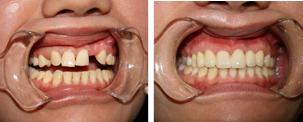If my teeth are not good-looking, how do I know if I am suitable for porcelain veneers?
The technology for porcelain-fused-to-metal (PFM) crowns is becoming increasingly mature, and the restorative effect of PFM crowns is also becoming more ideal. They are commonly used for aesthetic purposes on anterior teeth and for restoring damaged tooth structures, such as discolored teeth, tetracycline-stained teeth, malformed teeth, etc. Residual roots or residual crowns can also be restored with PFM crowns after root canal treatment.
**Indications for Porcelain Crowns**
1. **Missing Teeth**: Generally, this applies when there are a few missing teeth, and the adjacent teeth are healthy without inflammation, or if there is inflammation that has been treated and controlled. After a doctor's examination, PFM crown restoration may be considered.
2. **Unsatisfactory Tooth Color or Shape**: Such as tetracycline-stained teeth, fluorosis, hypoplasia, malformed teeth (too large or too small, twisted teeth), PFM crown restoration can be done.
3. **Abnormal Dental Arch Form That Is Not Suitable for Orthodontic Treatment**: Consider PFM crown restoration for patients who cannot undergo orthodontic treatment.
4. **Fractured Teeth or Residual Roots Due to Trauma**: If the tooth root has sufficient length and good periodontal condition, PFM crown restoration can be considered.
5. **Protruding Teeth, Retruded Teeth, Crowded Teeth, Sparse Teeth with Wide Gaps**: These conditions can be addressed with PFM crown restoration.
6. **Restoration After Tooth Treatment**: After pulp treatment, teeth are prone to discoloration, filling loss, and fracture. PFM full crown restoration can prevent these issues.
**Contraindications for Porcelain Crowns**
Some dental diseases are incompatible with PFM crowns. For example, severe periodontal disease; pathological changes in the root of the abutment tooth; pathological changes in the root or periodontium with significant alveolar ridge resorption; abnormal occlusal relationships, such as severe crossbite or overly tight bite; severe crown hard tissue loss reaching below the gum line, etc. Why are these dental conditions unsuitable for PFM crowns? For instance, severely loose teeth are not suitable for PFM crowns because periodontal disease often leads to gum recession, forming periodontal pockets, eventually exposing the tooth root and causing tooth mobility. Adding a porcelain crown on such teeth would increase the periodontal burden and worsen periodontal disease. If PFM crowns are necessary, they should only be done after periodontal disease is cured or controlled.
For further information about contraindications for PFM crowns, you can consult online experts to clarify any doubts.
Additionally, if the tooth structure is still alive but the nerve is not damaged, it should be preserved as much as possible. However, some unregulated clinics often remove the tooth nerve during PFM crown placement. This results in the tooth not receiving nutrients and moisture, gradually becoming brittle and easily breaking. Although PFM crowns are aesthetically pleasing, their function does not match that of natural teeth. Having PFM crowns does not mean a permanent solution. It is best to carefully consider before proceeding and seek treatment from qualified doctors at reputable hospitals to ensure the effectiveness and quality of the procedure.
